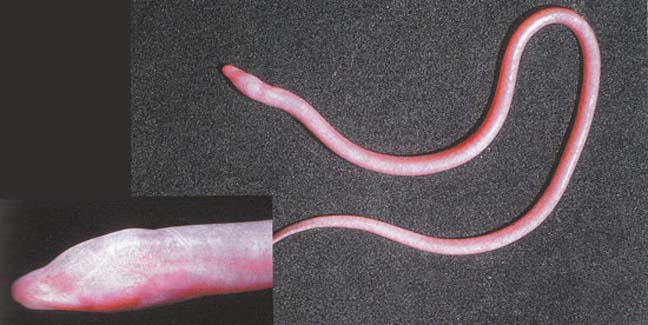Facts
Ophisternon candidum is one of the most
unique and interesting animals I have ever encountered. It lacks
eyes but has very well defined lips (at least for a fish).
(Mees, 1962) While it may appear to have a very unique morphology, one of its
closest relatives Ophisternon infernum, exhibits the same
atrophy of its eyes. (Humphrey & Feinerg, 1995)
While it may appear to have a very unique morphology, one of its
closest relatives Ophisternon infernum, exhibits the same
atrophy of its eyes. (Humphrey & Feinerg, 1995)
It is unique in being one of only two troglobitic invertebrates that call Australia home. (Mees, 1962) It is also quite rare. There are only thirteen instances of these creatures appearing together in pairs and only three instances of them being found together in a set of triplets. (Humphreys, 1999) With that being said, it is quite possible that the blind cave eel is found more with its troglobitic vertebrate counterpart the blind cave gudgeon than it is with itself. There has been only one instance of the blind cave eel being found without its partner. (Humphreys, 1999) While this animal and other troglobites like it might seem like definitive evidence for convergence and evolution in general, this wasn't always the case.
 The history of hypogean fishes in
general is a sadly under-researched history. Since their first
discovery there has been a debate about how they came about. There
have been several phases in the dominant thought on these fishes,
however each phase follows a similar pattern: a reemergence of an
old idea butting heads with the most modern ideas of evolution of
the time. This has involved the reemergence of Lamarck's ideas on
evolution and in time led to the term regressive evolution. Those
who subscribe to the idea of regressive evolution have been put in
to the orthogenesis school. This school of thought believes that
evolution is directional and has some sort of progression towards an
ideal form. Thus, a cave dwelling creature moving away from the peak
of evolutionary progress (humans), is obviously regressing.
Evolution has no directionality; this is one of the main tenets of
evolution taught in almost every class that covers the subject.
Selection pressures within the caves have simply pushed its denizens
towards their current forms. (Romero, 2001)
The history of hypogean fishes in
general is a sadly under-researched history. Since their first
discovery there has been a debate about how they came about. There
have been several phases in the dominant thought on these fishes,
however each phase follows a similar pattern: a reemergence of an
old idea butting heads with the most modern ideas of evolution of
the time. This has involved the reemergence of Lamarck's ideas on
evolution and in time led to the term regressive evolution. Those
who subscribe to the idea of regressive evolution have been put in
to the orthogenesis school. This school of thought believes that
evolution is directional and has some sort of progression towards an
ideal form. Thus, a cave dwelling creature moving away from the peak
of evolutionary progress (humans), is obviously regressing.
Evolution has no directionality; this is one of the main tenets of
evolution taught in almost every class that covers the subject.
Selection pressures within the caves have simply pushed its denizens
towards their current forms. (Romero, 2001)